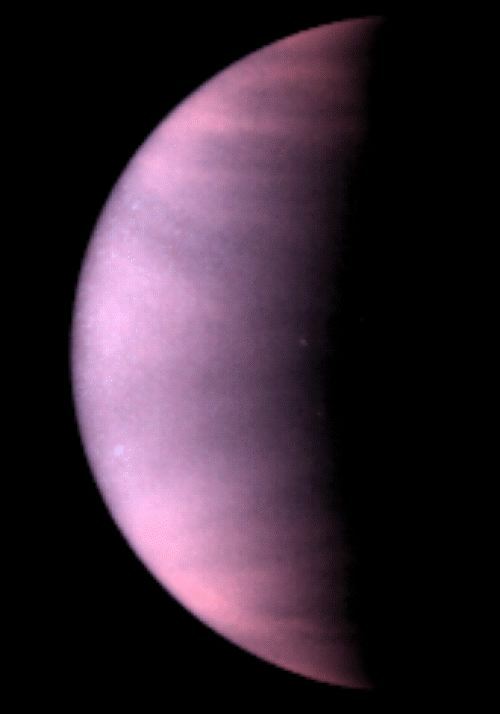
Size: 12401 km in diameter
Distance from the sun: 108 million km
Atmosphere: 96% carbon dioxide and 3.5% nitrogen
Rotation time: 224 days retrograde (backwards to that of Earth)
Revolution time: 243 days retrograde
Temperature: 475 C
Natural Satellites: none
After the moon, Venus is the most brilliant natural object in the night sky. It is the closest planet to Earth and is also the most similar to Earth in size, mass and density. These similarities suggest that the two planets may have similar histories. Scientist are intrigued by the question of why Venus and Earth are now so different from each other.
Venus rotates once every 243 days in retrograde motion--that is, in a direction opposite to the direction of rotation of most planets--or clockwise when viewed from above. The same side of Venus is always facing Earth when the two planets pass in orbit.
Venus' atmosphere is composed mainly of carbon dioxide, with droplets of sulfuric acid in the upper clouds. The upper atmosphere moves rapidly, completely circling the planet in four days, while winds at the surface are gentle. The surface temperature is approximately 750 k, even hotter than Mercury's 'noon' temperatures.
Because the clouds allow on about 15% of the sun's light to reach the planet, the days on Venus are dim and overcast. Since the dense atmosphere bends light, some light may extend around to the night side of the planet, so nights may not be completely dark.
It is thought that Venus may experience a form of plate techtonics, though the very high surface temperature probably makes the techtonic style quite different from that on Earth. The highest mountain on Venus, Maxwell Montes, is about 7.5 miles high. It may be a volcano. Radar images indicate that the high lands on Venus have rougher sufaces than do the other terrains.
The Magellan spacecraft arrived at Venus in mid-1990 and found that the surface of Venus is pocketed with large meteor craters. Magellan also found evidence that active volcanos may exist on Venus and that the surface of the planet is probably 400 million years old.